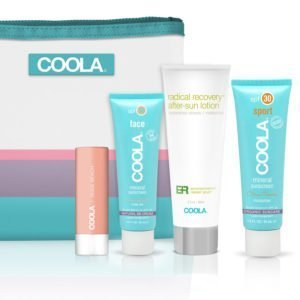Healthy Summer Skin Solutions
Choosing a Safe Sunscreen
The long days of summer are here and increased exposure to UV rays is something we all need to be aware of. Are you prepared to protect your skin during this time of increased outdoor activity? We hope to offer some helpful solutions for your summer skin that are safe and simple to implement.
Prolonged sun exposure can lead to premature aging of the skin, wrinkling, as well as suppression of the immune system. Covering up, wearing a hat, limiting exposure during peak hours of 10 a.m. to 4 p.m. and using sunscreen are just a few ways to protect yourself while outdoors.
If using sunscreen, it is important to choose a product that is safe for your skin and also has broad spectrum protection, meaning it effectively protects against significant portions of both the ultraviolet A (UVA) and ultraviolet B (UVB) ranges of the light spectrum. The Environmental Working Group (EWG)* discovered that 80% of sunscreens on the market offer “inferior sun protection or contain worrisome ingredients.” One ingredient commonly found in non-mineral sunscreens is oxybenzone. This chemical is a common UV filter in sunscreen and can disrupt the hormone system.
Classic vs. Mineral Sunscreen
Another important factor in choosing a sunscreen is classic vs. mineral. Classic and Mineral sunscreens are differentiated by their active sun protection ingredients. Classic sunscreens use chemical (also commonly referred to as “non-mineral” or “traditional”) active ingredients designed to absorb and dissipate UVA/UVB rays, while Mineral sunscreens use mineral (also commonly referred to as “physical”) active ingredients such as Titanium Dioxide and Zinc Oxide to scatter and reflect UVA/UVb rays. Since mineral actives are not absorbed into the skin these formulas are less irritating to sensitive skin and are also less likely to be absorbed into the bloodstream as “traditional” actives are.
At Osmosis, we currently offer COOLA brand sunscreen. COOLA uses as many ingredients as possible that are natural, organic, sustainable and locally sourced. Green, yet still luxurious, each of their high performance products protect and nourish the skin with vitamins and age-defying antioxidants, while remaining free of parabens, paba, petroleum and phthalates. Additionally, they formulate with Plant Protection® rather than Oxybenzone, which allows them to achieve clinically tested, broad spectrum and antioxidant-rich protections while using fewer traditional actives. Better for your skin, better for the environment. COOLA also offers both Mineral and Traditional active based sunscreens, using the healthiest active ingredients possible!
This month we are featuring our COOLA Mineral Travel Set, which includes a quartet of COOLA’s bestselling luxury mineral sun care must haves, all in TSA approved carry-on sizes! These high-performance products protect and nourish the skin with vitamins and age-defying antioxidants, while remaining free of undesirable chemicals. All in a reusable, travel-friendly and limited edition COOLA travel clutch! Order yours now just in time for Summer!
Additional Info
*EWG provides information on sunscreen products from the published scientific literature, to supplement incomplete data available from companies and the government.
The Environmental Working Group (EWG) sunscreen guide reviewed more than 1,700 SPF products like sunscreens, lip balms and moisturizers.
Since 2007, they have found a dramatic increase in the availability of mineral-only sunscreens, doubling from 17 percent of products to 34 percent in 2016. Sunscreens using zinc oxide and titanium dioxide tend to rate well in their analysis: They are stable in sunlight, offer a good balance between protection from the two types of ultraviolet radiation (UVA and UVB) and don’t often contain potentially harmful additives.
Oxybenzone is a common UV filter in sunscreen. It is a hormone disruptor and allergen. Sampling by the Centers for Disease Control and Protection has detected it in the urine of 97 percent of Americans. Despite emerging concerns, the sunscreen industry continues to rely heavily on oxybenzone as an active ingredient: it was in 70 percent of the non-mineral sunscreens evaluated for this year’s guide.



